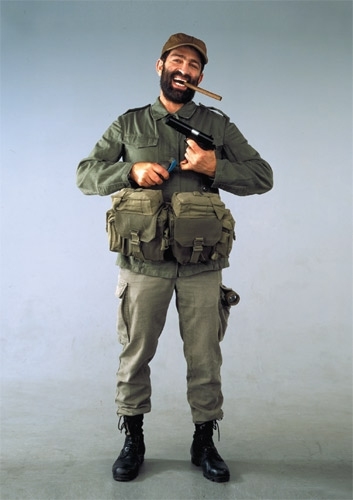The topic of the second exhibition, Identity II – Forming Identity, questions ambivalent models of interpreting the formation of identity, that, depending on the context, vary between identification and ideologization: According to Jan Assmann, collective identity is only “as strong or as weak as it is alive in the thoughts and actions of the group members […]”. It is the expression of that which connects people to each other through homogeneous self- and cultural identifiers and is how individuals identify themselves.
The forming of identity however, becomes suspect of being ideology as soon as it begins to delineate the adoption of cultural homogeneity or historical continuity. The manipulative use of identity to form a symbolic entity shows how it can be instrumentalized for the construction of larger groups. Such universalizing tendencies reveal themselves as a normative suggestion, thereby manifesting the affiliation of identity with autonomy even more significantly.
Oreet Ashery
Oreet Ashery reflects not only upon identity, but the construction thereof in her intervention in Dehli: For Portrait Sketch (2006), Ashery initially dresses up as an Orthodox Jewish man and has her portrait drawn by a street artist. On the same day, Ashery returns, this time wearing a keffiyeh and requests a portrait once again. Ashery’s performative intervention is not only a “cross-cultural dressing” operating with the stereotypes of Judaism and Islam, it is also a confrontation with gender identities. Can I Join You Just This Once? (2007) also casts the spotlight on religiously triggered gender differences as Ashery is demanded, because of her gender, to leave the demonstration of a group of anti-Zionist Orthodox Jews in London.
Hubert Blanz
Huber Blanz further developed his work public tracks (2010), which will be exhibited for the first time during the European Month of Photography 2010/2011 in Mutations III. Public Images – Private View, into an audio/video installation for the Fotogalerie Wien. Using a random person on Facebook as a starting point, Blanz connects the names of the person’s contacts forming a visual two-dimensional network. By transferring the resulting network into three dimensions for the audio/video installation, the viewer navigates through the space of the digital network. Unlike virtual identities in, for example, Second Life or chat forums, the identities on Facebook are composed of authentic aspects. This virtual space as a playground to try out alternative identities should therefore be interpreted neither as the disassociation of real identity nor as a deceptive maneuver. Rather it should be understood as a means to self-exploration. After all, a virtual identity experience has an impact on identity experienced in the real world.
Katharina Cibulka
Katharina Cibulka's video installation GETTING MY NAME UP THERE (2009/2010) confronts the viewer with a reality check, that should not be misunderstood as the examination of failure nor as a documentary. Ten years after her first film fireflies (1999), Cibulka surveys five women musicians about their life dreams. Yet now the artist disassociates the biographical narrative from the images – an irritation that does not necessarily generate confusion, but rather marks the constant variability of identity.
Cibulka’s video stressed out (2006) is an appropriation of Faith Wilding’s performance Waiting (1972). While Wilding’s reference to time can be read as a critique on concepts of linear identity in the context of Erik Erikson’s model of psychological development, Cibulka’s reference to the present speaks of today’s self-defined model of identity, that is experienced as two-edged: “Stressed out about not knowing what to want, what to choose“, reads one of the lines of text.
Shahram Entekhabi
Shahram Entekhabi’s attention is often drawn to questions of cultural and gender-specific identities. His migrant doppelganger characters expose prototypical masculine identities as well as their associated clichés. In his three performative video works, Mehmet, Mladen, and Miguel (2005) especially the influences of media stereotyping on the attributes of cultural and masculine identity are considered. The focus is thereby not only on the artist’s own migrant background, but includes numerous “foreign” cultural identities, that the artist humorously exaggerates. Entekhabi emphasizes the potential of aggression, of and against migrants and at the same time, his work points out the (negative) media instrumentalization of the lifeworld of the “other”.
Astrid Kornheuer
In her series Sammlungen (or Collections) (2007/2008), Astrid Korntheuer’s photographs depict bizarre arrangements of everyday objects that are exhibited by private collectors in small private museums. Beyond the documentary aspect of Korntheuer’s photographs, the single Smurf or football fan item disappears into the background, instead showing an involuntary tapestry woven from an abundance of staged objects. What appears to be a cabinet of curiosity of the second half of the 20th century demonstrates, with the help of an amateur classification system, the newly gained relevance of objects that transport the expression of everyday culture. Since hobby collectors attribute retrograde a special significance to objects, their subjective categorization provides a community a certain sense and contributes to the formation identity.
Trish Morrissey
For her performative series Front (2005–2007), Trish Morrissey merges the indexicality of the medium of photography with the disputed credibility of family portraits. On the beaches of Great Britain and Australia, the artist switches roles with a woman, usually the mother of a family, at times the woman member of a group of friends, both still strangers to the artist. Only the serial character of Morrissey’s supposed snapshots then reveals the initial ‘inconspicuousness’ of the artist, who as a cuckoo, appears to cross the boundaries of the ‘own’ family nest to the family nest of ‘strangers’: Familiar role models become unstable.
